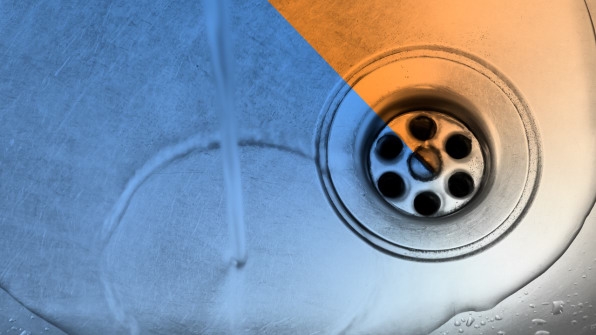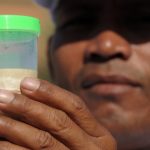This Database Tells You Which Bad Chemicals Are Hiding In Your Tap Water
In April 2015, Deborah Graham, a resident of the tiny town of Salisbury, North Carolina, received a letter from the North Carolina Division of Public Health, who wanted to let her know that the water coming out of her tap–the same water she used to fill her kids’ water bottles and cook dinner–was chock-full of vanadium, a coal-ash-derived chemical that causes nausea and, later in life, neurological decline. The public health authority also sent notices to 424 other households in the state.
Duke Energy, which supplies electricity for the state, had been depositing the ash created by burning coal into 32 pits throughout the state for decades. Coal ash contains radioactive materials and heavy metals; when it’s deposited into the pits, which are often unlined ponds, contaminants seep into the groundwater, through the local water system pipes, and from there make their way into people’s taps, water glasses, and bodies.
In the film From the Ashes, a Bloomberg Philanthropies-produced documentary that premiered last month, we see Graham hauling 24-packs of bottled water into her home to drink and cook with, while waging an advocacy battle against Duke Energy, demanding that the utility shell out the tens of millions it will take to clean up the water supply.

Graham’s situation is far from unique. The Environmental Working Group’s updated Tap Water Database aggregated data from 2010 to 2015 from 50,000 utilities across all 50 states, and found traces of over 250 contaminants. Over 160 of those contaminants are unregulated, which means that despite their known adverse health effects, there’s no law limiting their presence in water supplies.
The database was first launched in 2004, Nneka Leiba, EWG’s director of healthy living science, tells Fast Company; since then, updates were released in 2009 and now in 2017. “One of the reasons it takes us a while to update the database is also one of the reasons why it’s so important,” she says. “It’s the only available database that is this comprehensive and tells Americans what they’re drinking.”
Anyone can access the database, enter their zip code, and see a list of utilities that serve their area, as well as the contaminants found in their water. While the Environmental Protection Agency sets legal limits, measured in parts per billion (ppb) on a handful of chemicals, like chloroform and trichloroacetic acid (both known carcinogens); under those regulations, water utilities must comply with a certain level of contamination or face a fine. But legal limits, Leiba says, are not necessarily health-protective limits. “They’re a compromise between health, cost, and feasibility,” she says. What the EWG has done with this update of the Tap Water Database is to develop and establish what they’re calling “EWG standards,” which reflect truly health-protective limits. “So for nitrates, we’re not looking at 10 ppb, which is the legal limit; we’re looking at how many people are affected by levels over 5 ppb, which could be cancerous,” Leiba says.

Nitrates are among the most common contaminants in the EWG database; the researchers detected high levels of the chemical in all 50 states. A chemical fertilizer found in the soil due to agricultural and urban runoff, excess nitrates can cause oxygen deprivation in young children and increase cancer risks. Other common culprits, also found in all 50 states, include chromium-6, a pervasive carcinogen that leaks into water from industrial waste sites, and lead, the excessive presence of which in Flint, Michigan’s water ignited a national outcry.
But the database, for the most part, steers clear of sweeping generalizations about trends in the national water supply, but Leiba notes that contamination levels tend to rise as incomes lower. In the 79406 zip code of Lubbock, Texas, where the per-capita household income is $2,905, EWG found 12 contaminants above the health limit; in Manalapan, Florida (not coincidentally, not far from Mar-A-Lago), the per-capital income is $143,729, and just two contaminants were detected.
The reason EWG wants to keep the focus on the local issues is to get people engaged with what’s going on with their own water supplies, and take action against the utilities, like Graham did, to remedy the source. “The first thing to do is identify and acknowledge that there is a problem,” Leiba says. For anyone concerned about the quality of their tap water, the EWG database lists all local utilities and contaminants (to find your utility, check your water bill), as well as which industries are responsible for the pollutants. “Through community action, people can push state and federal legislators to strengthen policies,” Leiba says. “We think that Americans have the right to know about this so they can push for improvements, push for stronger standards, and push for upgrades to treatment and infrastructure—the onus is not just on the utilities.”
Demand better regulations from your legislators (and buy a filter in the meantime).
In April 2015, Deborah Graham, a resident of the tiny town of Salisbury, North Carolina, received a letter from the North Carolina Division of Public Health, who wanted to let her know that the water coming out of her tap–the same water she used to fill her kids’ water bottles and cook dinner–was chock-full of vanadium, a coal-ash-derived chemical that causes nausea and, later in life, neurological decline. The public health authority also sent notices to 424 other households in the state.
Fast Company , Read Full Story
(28)








